
Recently, Massachusetts apple grower Mo Tougas was saddled with a labour problem.
Recently, Massachusetts apple grower Mo Tougas was saddled with a labour problem.
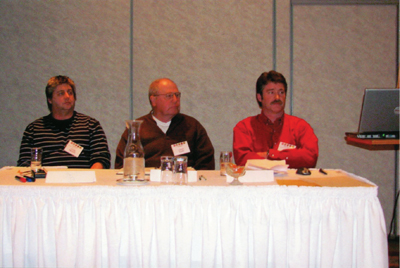 |
| Nova Scotia growers (left to right) Craig Nichols, Lloyd Dyck and Blake Sarsfield describe the time-saving shortcuts they have used in their orchards. Advertisement
Photo by Dan Woolley
|
Uncertain about how much longer his Northboro, MA, area orchard would have access to its offshore Jamaican work force, the operator of Tougas Family Farm – recently named one of the 10-best apple picking operations in the United States – began searching for labour-saving equipment. Tougas was looking for something that could reach the top of his trees for harvesting plus would be adaptable for harvesting, pruning and thinning his peach trees as well as pruning, hand thinning, branch-tying and harvesting his apple trees. He also wanted something diesel powered that used components he could easily source locally if there was a need for parts or repairs.
Initially, Tougas went the home-built route, modifying an old International Harvester tractor with a homemade platform. He used it for one season.
“It really helped quite a bit, even though it was a lost-cost sort of deal,” he explained during a recent presentation at the Nova Scotia Fruit Growers Association’s annual conference.
In 2008, he found a significant improvement in labour efficiency with the purchase of a $30,000 Italian-built, four-wheeled, self-propelled scissors lift platform for picking, pruning and trimming in his orchard. Built by Bosi, the platform is powered by a Perkins diesel with controls and parts easily available in the U.S. As an option, Tougas added a new air compressor that can operate four pruners simultaneously as well as a pneumatic chain saw.
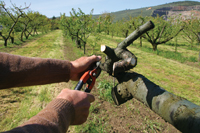 |
| Massachusetts apple grower Mo Tougas turned to a motorized platform so he could reach the top of his peach and apple trees for harvesting, pruning and thinning.
|
The platform has four-wheel, independent, front and rear steering and can be tilted from side to side, left or right, when working in sloped orchards. The platform is also equipped with hydraulic forks for lifting bins during picking. The platform holds two bins that, once filled, can be moved via the rollers off the platform, onto the forks and lowered to a waiting bin trailer.
The platform’s 16-inch tractor lug tires are mounted on 50-inch-wide axles and the platform can be extended to a total width of 96 inches.
The platform is useful in a row spacing of up to 15 feet wide, although Tougas suggested a row spacing of 10 to 12 feet is ideal when using the platform for apples. “You can work on trees up to 15 feet tall,” said Tougas. “It is most efficient on fruit wall systems where there is a consistent canopy to work on.”
It is also ideal for working within tall support systems, such as super spindle in apples or perpendicular V-trellis for peaches, he added.
Tougas has experienced a 30 per cent time saving when pruning from the platform, noting it takes a few seasons to get used to the versatile machine.
“We also use it to put rolls of bird netting over our cherries and blueberries.”
Nova Scotia know-how
Nova Scotia producers have also been searching for labour saving equipment to help with worker efficiency in the orchard. Apple producer Craig Nichols bought a tractor last year, modifying it to more efficiently handle his style of bins, which he tows in special bin trailers that hold six at a time. This extra bin payload helps to reduce the number of times the tractor had to be in and out of the orchard during the harvest. Last year, Nichols had two bin trailers working so that as soon as one was filled, it could be replaced with an empty one. He has since added a third trailer for the 2010 season.
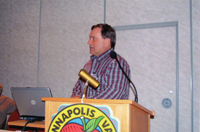 |
| Mo Tougas uses a self-propelled scissors lift platform to save time and money in his Massachusetts orchard.
|
Fellow apple grower Blake Sarsfield also operates bin trains, composed of three wagons with two bins on each wagon. They are equipped so his pickers can ride on the train, filling the bins as it moves through the orchard. Sarsfield runs five bin trains with three picking crews. Two of the trains stand empty so that once a train is full, an empty train can be dispatched to the orchard to replace it.
Sarsfield has found that by using this harvesting system, there is less weight being applied and less compaction occurring to the orchard floor. While the trains might have a tight turning radius, Sarsfield conceded they do not work in a V-trellis system. It is a good system for use when harvesting Honeycrisp, but Sarsfield said he has found it is labour intensive.
Because one of his highest costs is hand thinning, Sarsfield has been looking at using a mechanical blossom thinner for his peach crop. He explained that four Nova Scotia growers had joined forces last season and purchased one of the mechanical thinners. Sarsfield believes it would also be helpful for spur thinning Honeycrisp.
Apple grower Lloyd Dyck has also been busy finding labout efficiencies in his orchard. “The biggest thing we have done over the years to make our orchard more efficient is to plant bigger blocks of the same thing,” he said, adding he also prunes heavily, has cut back on fertilizer application and opened up his trees so suckering is reduced.
Dyck’s orchard rows are 14 to 16 feet wide to increase light penetration into the tree rows to optimize fruit growth. The rows are also mown only once or twice during the growing season to save time and money.
Dyck has saved considerable money by building his own highway transportable air-pruning trailer. It uses a 13 horsepower engine to drive a 175 psi air compressor and holds several reels of 600 foot long hose fitted with Italian-made air pruners. Dyck estimates it would have cost him $12,000 to purchase, but he built the trailer for $5,700.
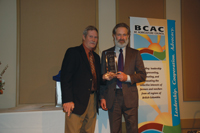
|
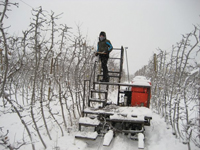
|
| Investment Agriculture Foundation of British Columbia chair Stuart Wilson (left) presents Roger Bailey with the 2010 Award of Excellence for Innovation in Agriculture and Agri-Food during the recent Ag Gala.
|
Using recycled Japanese rice harvesters, Roger Bailey of Kalwood Farms in Oyama, B.C., developed a mobile work platform designed for use in his orchards. |
| Okanagan orchardist wins award for innovation The Investment Agriculture Foundation of British Columbia (IAF) recently announced the recipient of the 2010 Award of Excellence for Innovation in Agriculture and Agri-Food. Roger Bailey of Kalwood Farms in Oyama, B.C., is this year’s award recipient. Bailey was recognized for his mobile work platform that creates safer and more efficient working conditions in B.C. orchards. Using recycled Japanese rice harvesters, Bailey adapted the design for “Without the need for ladders, Bailey’s mobile work platform helps Bailey is no stranger to developing farm machinery, creating a Bailey is a full-time farmer and sits on the boards of the B.C. Fruit “Winning the 2010 Award of Excellence for Innovation is great positive The IAF Award of Excellence for Innovation in Agriculture and Agri-Food |
Print this page